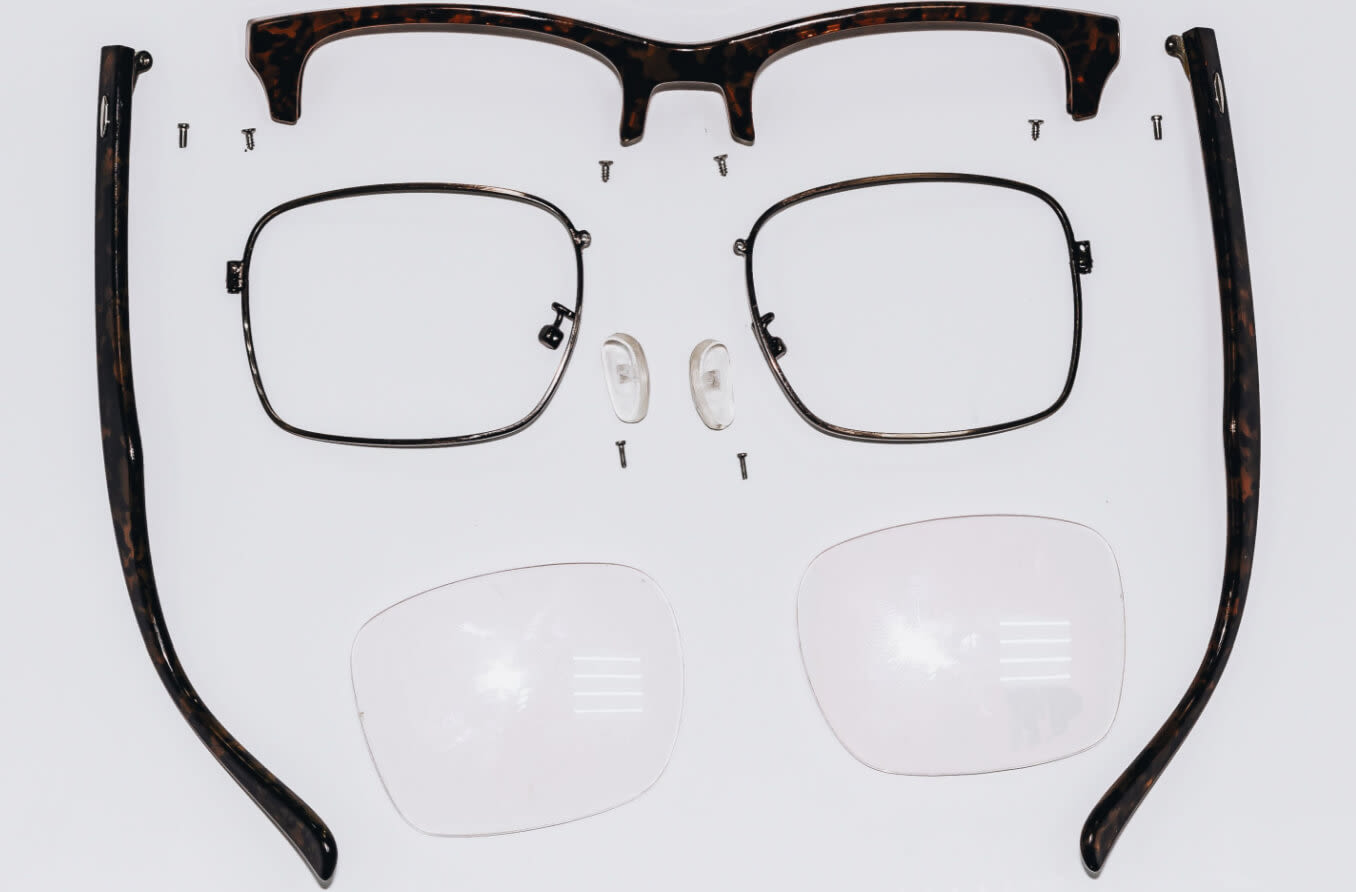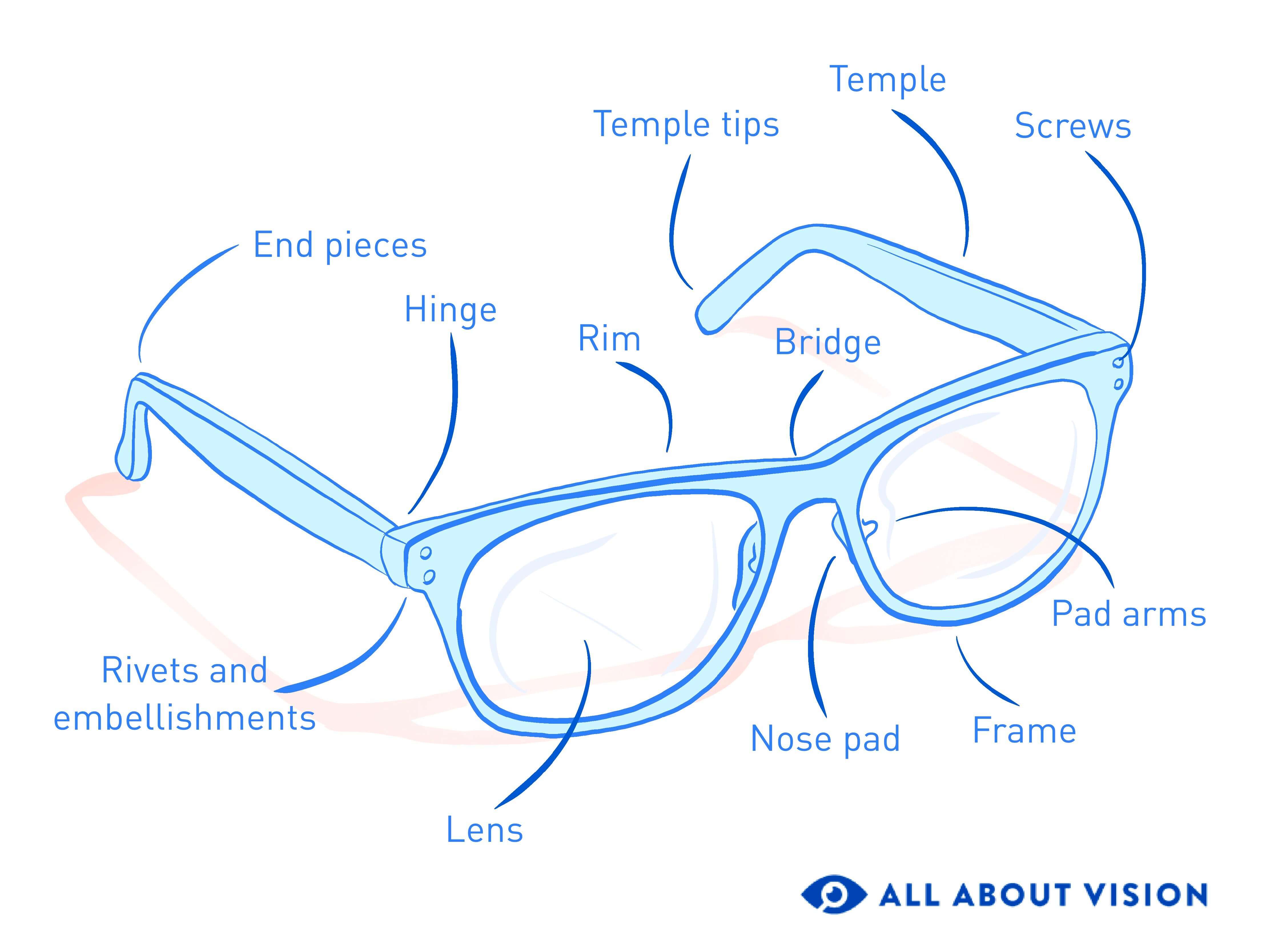Parts of glasses & their functions

Parts of eyeglasses
When you think of the function of your glasses, vision correction is often the first thing that comes to mind. But in order to achieve sharp vision through prescription lenses, several eyeglass frame structures must work together to hold the eyewear in place.
There are 10 main parts of eyeglasses that make up the overall design. These include:

Click on image to enlarge.
Lenses
Rims
Bridge
Nose pads
Pad arms
Temples
End pieces
Hinges
Screws
Rivets and embellishments
Below you will find a diagram of glasses parts and a guide to each piece of hardware. If needed, you can reference this list the next time you need a frame adjustment from your optician or if you’re just curious about how eyeglasses work.
1. Lenses
The lenses are the clear pieces of plastic, glass or similar material that sit in front of your eyes. Eyeglass lenses contain your personal eye prescription so that you can see clearly as you look through them.
2. Rims
The rims hold your lenses in place within the eyeglass frame. Rims are also the part of the glasses that give them their shape, whether you choose a pair of rectangular, square, round or cat-eye frames.
You may also have the option of getting rimless or semi-rimless glasses if you prefer. This provides more of an exposed or barely there feel to your frames.
3. Bridge
The rims meet in the center of the frame, where they are held together by the bridge. The bridge sits on the top part of your nose in standard glasses. People with wide-set noses may prefer a pair of low-bridge glasses for a more comfortable fit.
4. Nose pads
Under the bridge and next to each lens, you may find two round pads made of plastic. These are called nose pads and they are meant to help keep your glasses secure and comfortable.
Some frames, especially most plastic ones, don’t have nose pads.
5. Pad arms
If your glasses have nose pads, they’ll likely also have pad arms. These are the small pieces of hardware between the rims and the nose pads that hold the nose pads in place. If your nose pads are too tight or loose, flexing or adjusting the pad arms can help fit them to your face.
6. Temples
Eyeglass temples, also called “arms,” are the long pieces on each side of your frames that fit behind your ears and keep your glasses on your face. The temples are what you fold in behind your lenses when you’re getting ready to put your glasses away.
7. End pieces
You’ll find the end pieces in the top right and left corners of your glasses. They extend past the rims, attaching the temples to the lenses.
8. Hinges
Hinges are located between the temples and end pieces. The hardware houses the mechanism that allows you to open and close the arms of your glasses.
Some types of hinges are fastened with small screws called rivets. If your glasses have rivets, you’ll see them on the front or side of the end pieces.
9. Screws
Next to the hinges, you’ll find small metal screws. These pieces connect the temples and end pieces to keep your glasses together.
Are your glasses loose-fitting? You may need to have the screws tightened. Ask your optician for help or use a small screwdriver from a glasses repair kit to make minor adjustments.
SEE RELATED: 5 Signs your glasses don't fit
10. Rivets and embellishments
Rivets are small screws located on the front or sides of the end pieces. They’re commonly round in shape, but they can also be oval, rectangular or another design. Not only do rivets give frames an extra flair, but they also help keep the hinges tightly fastened. Not all glasses have functional rivets; it depends on the type of hinges in your frames.
Many frames also have a decorative element to make them more stylish or unique. Rhinestones, gems and metal embellishments are examples of this. While they’re not always crucial to the structure of your glasses, embellishments can add to their overall appearance.
Eyeglasses parts vs. sunglasses parts
Sunglasses have the same basic structure as eyeglasses. The main difference between the two is that sunglasses tend to have darker-tinted lenses. Standard eyeglass lenses are transparent unless you opt for tinted lenses, Transitions lenses or a similar feature.
Sunglass lenses come in hues such as gray, blue, green or amber and work by reducing the amount of light that enters the eyes. In most cases, sunglasses can be fitted with prescription lenses for vision correction.
Sunglasses can also protect your eyes from harmful ultraviolet (UV) rays while you’re outdoors. Be sure to choose a pair labeled as having 100% UV protection or as UV 400 to help keep your eyes safe in the sun.
Aside from the difference in lenses, sunglasses can also flaunt more complex designs, shapes and materials than regular eyeglasses.
Both eyeglasses and sunglasses are beneficial in their own way. Since both types of eyewear share the same fundamental parts, any given adjustment or repair method is similar across the board. Be sure to consult your eye care specialist before making any frame repairs or adjustments yourself.
READ NEXT: How long does it take to adjust to new glasses?
Tips for choosing the best sunglasses. EyeSmart. American Academy of Ophthalmology. June 2021.
Page published on Tuesday, February 20, 2024
Page updated on Tuesday, February 27, 2024
Medically reviewed on Thursday, February 15, 2024






